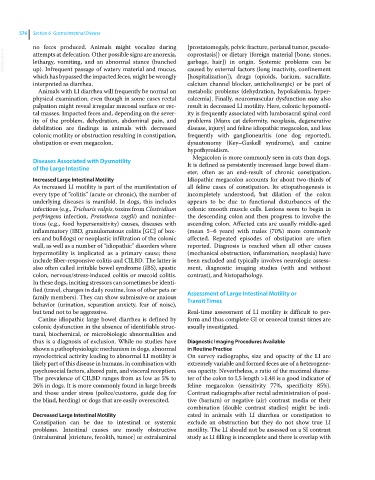Page 608 - Clinical Small Animal Internal Medicine
P. 608
576 Section 6 Gastrointestinal Disease
no feces produced. Animals might vocalize during [prostatomegaly, pelvic fracture, perianal tumor, pseudo-
VetBooks.ir attempts at defecation. Other possible signs are anorexia, coprostasis]) or dietary (foreign material [bone, stones,
garbage, hair]) in origin. Systemic problems can be
lethargy, vomiting, and an abnormal stance (hunched
up). Infrequent passage of watery material and mucus,
[hospitalization]), drugs (opioids, barium, sucralfate,
which has bypassed the impacted feces, might be wrongly caused by external factors (long inactivity, confinement
interpreted as diarrhea. calcium channel blocker, anticholinergic) or be part of
Animals with LI diarrhea will frequently be normal on metabolic problems (dehydration, hypokalemia, hyper-
physical examination, even though in some cases rectal calcemia). Finally, neuromuscular dysfunction may also
palpation might reveal irregular mucosal surface or rec- result in decreased LI motility. Here, colonic hypomotil-
tal masses. Impacted feces and, depending on the sever- ity is frequently associated with lumbosacral spinal cord
ity of the problem, dehydration, abdominal pain, and problems (Manx cat deformity, neoplasia, degenerative
debilitation are findings in animals with decreased disease, injury) and feline idiopathic megacolon, and less
colonic motility or obstruction resulting in constipation, frequently with ganglioneuritis (one dog reported),
obstipation or even megacolon. dysautonomy (Key–Gaskell syndrome), and canine
hypothyroidism.
Megacolon is more commonly seen in cats than dogs.
Diseases Associated with Dysmotility It is defined as persistently increased large bowel diam-
of the Large Intestine
eter, often as an end‐result of chronic constipation.
Increased Large Intestinal Motility Idiopathic megacolon accounts for about two‐thirds of
As increased LI motility is part of the manifestation of all feline cases of constipation. Its etiopathogenesis is
every type of “colitis” (acute or chronic), the number of incompletely understood, but dilation of the colon
underlying diseases is manifold. In dogs, this includes appears to be due to functional disturbances of the
infectious (e.g., Trichuris vulpis, toxins from Clostridium colonic smooth muscle cells. Lesions seem to begin in
perfringens infection, Prototheca zopfii) and noninfec- the descending colon and then progress to involve the
tious (e.g., food hypersensitivity) causes, diseases with ascending colon. Affected cats are usually middle‐aged
inflammatory (IBD, granulomatous colitis [GC] of box- (mean 5–6 years) with males (70%) more commonly
ers and bulldogs) or neoplastic infiltration of the colonic affected. Repeated episodes of obstipation are often
wall, as well as a number of “idiopathic” disorders where reported. Diagnosis is reached when all other causes
hypermotility is implicated as a primary cause; these (mechanical obstruction, inflammation, neoplasia) have
include fiber‐responsive colitis and CILBD. The latter is been excluded and typically involves neurologic assess-
also often called irritable bowel syndrome (IBS), spastic ment, diagnostic imaging studies (with and without
colon, nervous/stress‐induced colitis or mucoid colitis. contrast), and histopathology.
In these dogs, inciting stressors can sometimes be identi-
fied (travel, changes in daily routine, loss of other pets or Assessment of Large Intestinal Motility or
family members). They can show submissive or anxious Transit Times
behavior (urination, separation anxiety, fear of noise),
but tend not to be aggressive. Real‐time assessment of LI motility is difficult to per-
Canine idiopathic large bowel diarrhea is defined by form and thus complete GI or orocecal transit times are
colonic dysfunction in the absence of identifiable struc- usually investigated.
tural, biochemical, or microbiologic abnormalities and
thus is a diagnosis of exclusion. While no studies have Diagnostic Imaging Procedures Available
shown a pathophysiologic mechanism in dogs, abnormal in Routine Practice
myoelectrical activity leading to abnormal LI motility is On survey radiographs, size and opacity of the LI are
likely part of this disease in humans, in combination with extremely variable and formed feces are of a heterogene-
psychosocial factors, altered pain, and visceral reception. ous opacity. Nevertheless, a ratio of the maximal diame-
The prevalence of CILBD ranges from as low as 5% to ter of the colon to L5 length >1.48 is a good indicator of
26% in dogs. It is more commonly found in large breeds feline megacolon (sensitivity 77%, specificity 85%).
and those under stress (police/customs, guide dog for Contrast radiographs after rectal administration of posi-
the blind, herding) or dogs that are easily overexcited. tive (barium) or negative (air) contrast media or their
combination (double contrast studies) might be indi-
Decreased Large Intestinal Motility cated in animals with LI diarrhea or constipation to
Constipation can be due to intestinal or systemic exclude an obstruction but they do not show true LI
problems. Intestinal causes are mostly obstructive motility. The LI should not be assessed on a SI contrast
(intraluminal [stricture, fecolith, tumor] or extraluminal study as LI filling is incomplete and there is overlap with

